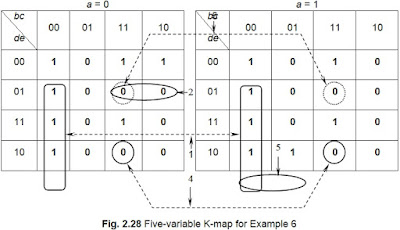Figure 2.27 shows a five-variable K-map. The variables may be designated as a, b, c, d, and e, respectively.
Now, consider Group 1 in the figure. We have a quad in chart a = 0 and a similar quad in chart a = 1. Since these two quads occupy similar positions in the two charts, we group them together to form an octet. The resultant terms for Group 1 is b′c′. Group 2 has entries in chart 1 only, and reduces to a′bd′e′. Group 3 has a single entry in chart 1, and a single entry in chart 2. The reduced term then is bcd′e′. Group 4 is similar to group 3 and reduces to bcde. Finally group 5 gives ab′de′. The solution, therefore, is:
S = a′c′ + b′c′+ ade′ + bde + a′d′e′ (2.31)
The five-variable K-map is in effect two four-variable K-maps drawn horizontally to form an extension of each other. The two four-variable maps are designated as a = 0 and a = 1, respectively. Thus, the map a = 0 represents cells designated from 00000 (≡decimal 0) to 01111 (≡decimal 15) and the map a = 1 represents cells designated from 10000 (≡decimal 16) to 11111 (≡decimal 31). The simplification using the five-variable K-map is slightly complex and requires a lot of careful inspection of the two constituent maps. We shall now consider an example to illustrate the simplification process in a five-variable K-map.
Example 6: Simplify S = S (0, 1, 2, 3, 8, 12, 15, 16, 17, 18, 19, 22, 28, 31)
Solution: We know that adjacent-cell entries can be reduced by grouping them. In Fig. 2.27, we have two separate charts or maps. How do we go about to find the adjacencies? There is no real difficulty in this if we consider the fact that the two charts themselves are adjacent to one another with the main element a = 0 for the first map and a = 1 for the second map. For example, the entries in the zeroth cell and the sixteenth cells are adjacent to each other because the zeroth cell represents 00000 and the sixteenth cell 10000. The two cells differ in the variable ‘a’ only and this gets eliminated if we group the entries in cells 0 and 16 together. In fact, a gets eliminated whenever the entries in corresponding cells of both the charts can be grouped together. Based on this principle, the entries of the given example are grouped, as shown in Fig. 2.28.
Now, consider Group 1 in the figure. We have a quad in chart a = 0 and a similar quad in chart a = 1. Since these two quads occupy similar positions in the two charts, we group them together to form an octet. The resultant terms for Group 1 is b′c′. Group 2 has entries in chart 1 only, and reduces to a′bd′e′. Group 3 has a single entry in chart 1, and a single entry in chart 2. The reduced term then is bcd′e′. Group 4 is similar to group 3 and reduces to bcde. Finally group 5 gives ab′de′. The solution, therefore, is:
S = b′c′ + a′bd′e′+ bcd′e′ + bcde + ab′d′e′ (2.30)
It may be noted that don’t-care terms can appear in five-variable maps also. The following example illustrates this.
Example 7: Reduce S = S (1, 2, 3, 8, 9, 10, 12, 15, 16, 17, 18, 22, 26, 27) + d (0, 4, 11, 19, 28, 29, 30, 31)
Solution: The K-maps for Example 7 is shown in Fig. 2.29.
From Fig. 2.29, we obtain the final expression as:



